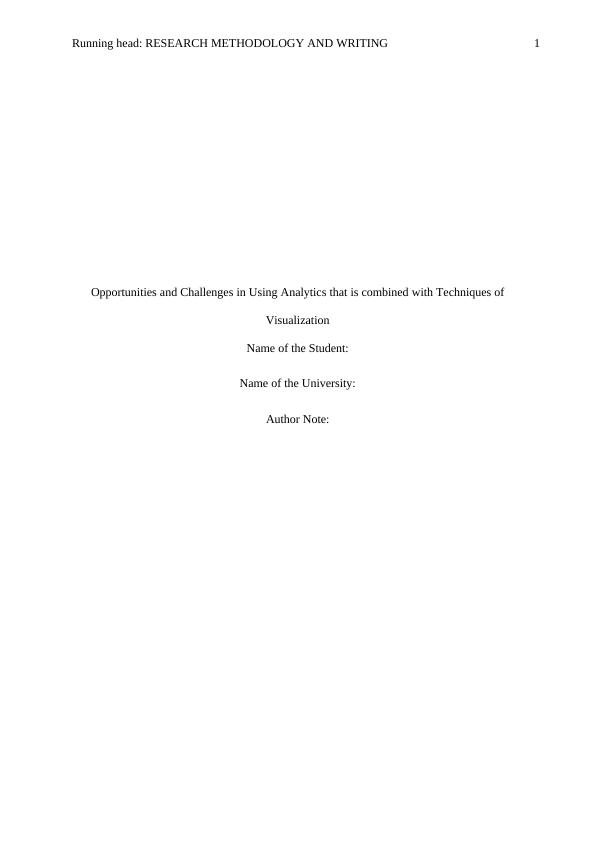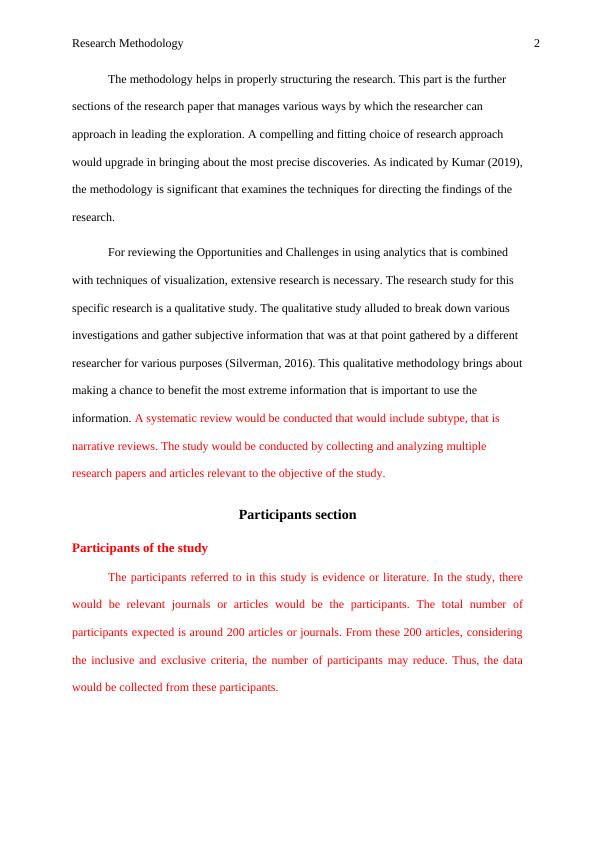RESEARCH METHODOLOGY AND WRITING
Added on 2022-09-03
10 Pages2378 Words18 Views
Running head: RESEARCH METHODOLOGY AND WRITING 1
Opportunities and Challenges in Using Analytics that is combined with Techniques of
Visualization
Name of the Student:
Name of the University:
Author Note:
Opportunities and Challenges in Using Analytics that is combined with Techniques of
Visualization
Name of the Student:
Name of the University:
Author Note:

Research Methodology 2
The methodology helps in properly structuring the research. This part is the further
sections of the research paper that manages various ways by which the researcher can
approach in leading the exploration. A compelling and fitting choice of research approach
would upgrade in bringing about the most precise discoveries. As indicated by Kumar (2019),
the methodology is significant that examines the techniques for directing the findings of the
research.
For reviewing the Opportunities and Challenges in using analytics that is combined
with techniques of visualization, extensive research is necessary. The research study for this
specific research is a qualitative study. The qualitative study alluded to break down various
investigations and gather subjective information that was at that point gathered by a different
researcher for various purposes (Silverman, 2016). This qualitative methodology brings about
making a chance to benefit the most extreme information that is important to use the
information. A systematic review would be conducted that would include subtype, that is
narrative reviews. The study would be conducted by collecting and analyzing multiple
research papers and articles relevant to the objective of the study.
Participants section
Participants of the study
The participants referred to in this study is evidence or literature. In the study, there
would be relevant journals or articles would be the participants. The total number of
participants expected is around 200 articles or journals. From these 200 articles, considering
the inclusive and exclusive criteria, the number of participants may reduce. Thus, the data
would be collected from these participants.
The methodology helps in properly structuring the research. This part is the further
sections of the research paper that manages various ways by which the researcher can
approach in leading the exploration. A compelling and fitting choice of research approach
would upgrade in bringing about the most precise discoveries. As indicated by Kumar (2019),
the methodology is significant that examines the techniques for directing the findings of the
research.
For reviewing the Opportunities and Challenges in using analytics that is combined
with techniques of visualization, extensive research is necessary. The research study for this
specific research is a qualitative study. The qualitative study alluded to break down various
investigations and gather subjective information that was at that point gathered by a different
researcher for various purposes (Silverman, 2016). This qualitative methodology brings about
making a chance to benefit the most extreme information that is important to use the
information. A systematic review would be conducted that would include subtype, that is
narrative reviews. The study would be conducted by collecting and analyzing multiple
research papers and articles relevant to the objective of the study.
Participants section
Participants of the study
The participants referred to in this study is evidence or literature. In the study, there
would be relevant journals or articles would be the participants. The total number of
participants expected is around 200 articles or journals. From these 200 articles, considering
the inclusive and exclusive criteria, the number of participants may reduce. Thus, the data
would be collected from these participants.

Research Methodology 3
Type of Sampling
The sample type is convenience as the researcher, or author would select the journals
or articles according to convenient and which is relevant to the objective of the study. The
articles or journals that would be collected for conducting the research would be no old than
six years for achieving the most reliable data and information.
Criteria for selecting studies
The studies or works of literature that should be utilized in the systematic review are
from different sources and various libraries. The electronic database has been utilized for
recovering the different journals along with peer-reviewed articles.
Inclusive Criteria
The research includes all the relevant studies or literature that needs to accomplish the
objectives of the research. The studies that address the subject of analytics, big data
visualization, traditional data visualization, and related matter are included in the studies.
Another inclusive factor considers the studies or papers, which include visualization methods
such as bible charts, graphs, scatter plot, histogram, data flow diagram, and any other related
graphs.
Exclusive Criteria
The studies that have issues in biasness of the findings, length of the studies or paper,
and issues in the sample size are considered as a factor for the exclusion of the studies. The
studies are also excluded if the language of the research is not in English, and if the papers do
not draw the intervention related to the objectives of the study or research.
Type of Sampling
The sample type is convenience as the researcher, or author would select the journals
or articles according to convenient and which is relevant to the objective of the study. The
articles or journals that would be collected for conducting the research would be no old than
six years for achieving the most reliable data and information.
Criteria for selecting studies
The studies or works of literature that should be utilized in the systematic review are
from different sources and various libraries. The electronic database has been utilized for
recovering the different journals along with peer-reviewed articles.
Inclusive Criteria
The research includes all the relevant studies or literature that needs to accomplish the
objectives of the research. The studies that address the subject of analytics, big data
visualization, traditional data visualization, and related matter are included in the studies.
Another inclusive factor considers the studies or papers, which include visualization methods
such as bible charts, graphs, scatter plot, histogram, data flow diagram, and any other related
graphs.
Exclusive Criteria
The studies that have issues in biasness of the findings, length of the studies or paper,
and issues in the sample size are considered as a factor for the exclusion of the studies. The
studies are also excluded if the language of the research is not in English, and if the papers do
not draw the intervention related to the objectives of the study or research.

End of preview
Want to access all the pages? Upload your documents or become a member.
Related Documents
Exploring Nurses' Experiences in Medication Safety Practicelg...
|7
|2013
|82
Research Methodology for Wireless LAN Researchlg...
|4
|695
|35
Research Inquiry Development in Healthcarelg...
|10
|2330
|72
Rate Of Teenage Suicide Worldwidelg...
|13
|2634
|19
Systematic Review: Experience of International Nursing Studentslg...
|33
|6045
|338
Effective Interventions for Preventing Childhood Obesity in School Age Childrenlg...
|38
|7007
|45
